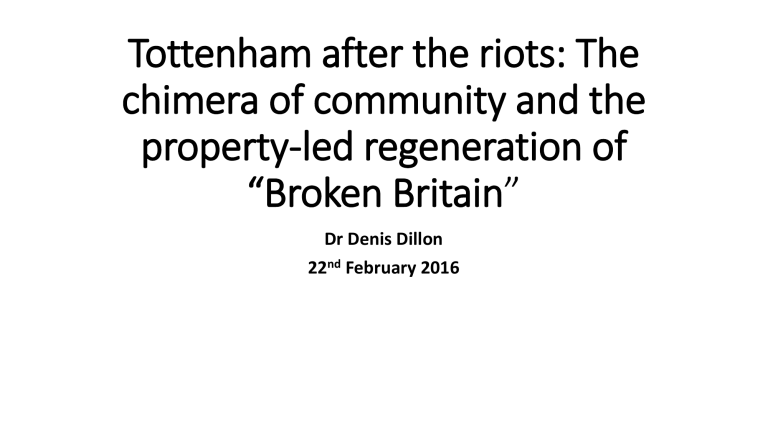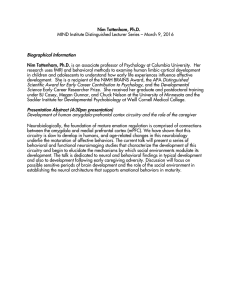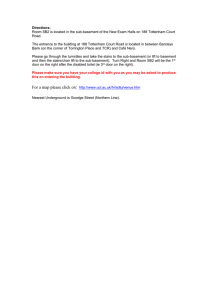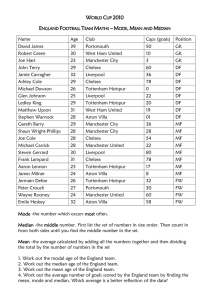Tottenham after the riots: The chimera of community and the “Broken Britain”

Tottenham after the riots: The chimera of community and the property-led regeneration of
“Broken Britain”
Dr Denis Dillon
22 nd February 2016
Deprivation in Tottenham
Policy context at the time of the 2011
Tottenham riots
• A shift away from an urban policy predicated on the targeting of dedicated programmes and resources towards deprived communities
• A retreat from efforts to build community capacity and engage local communities in urban renewal
• The embrace of market-led and property-led regeneration and a local economic policy that sought to promote business growth in all localities
• A claimed commitment to localism
• For the 1 st time in 40 years, the abandonment of the principle of targeting resources towards deprived localities
Who remembers the Big Society?
• The Coalition Government’s overarching political narrative
• Marked a rupture with the centralist and more statist approach of the previous New Labour government
• Promotes voluntarism and community enterprise as a replacement the state, particularly at local level
• An extension in the role of the private sector in the delivery of public services
• Can be located within an ongoing renegotiation on the role of individuals, communities and the state within British social policy
After the riots – institutional diagnoses of their underlying causes
After the Riots: The Final Report of the Communities and Victims Panel
(2012)
One of a number of published studies of the causes of the riots.
Argued that the causes of the riots included:
• High youth unemployment
• “toxic” relations between young people and the police
• Particular focus on young people who were not in employment, education of training (NEET)
• Noted that of children brought before the courts, because of the riots, two thirds had special educational needs. They were also more likely to be in receipt of free school meals and be living on on of the 10% most deprived areas
It Took Another Riot (2012)
Report of Panel appointed by the Mayor of London.
Identified poor housing, legacy of industrial decline and government failure as some of the key causes of social problems in Tottenham.
However there was also a major emphasis on the idea of a community deficit:
• The estimated 900 “troubled” families in Tottenham
• Population turnover and transience
• Tottenham’s high proportion of welfare dependant families
Community in the dock?
“a minority of individuals have become over-reliant on the state, at time treating with a sense of entitlement, benefits that were intended to serve as a support”
Report describes “a dismal environment of intergenerational unemployment, boredom, poor aspiration, households at the very sharpest end of poverty, children with depression, parents with substance addictions and domestic violence”
It criticises some local community groups accusing them of resisting
“any measures to better Tottenham whilst constantly blaming others for its problems”
Analysis of recommendations
Emphasis on the need for the Tottenham’s vulnerable communities to develop resilience whilst similarly betting that a programme of property-led regeneration would turn the area around
• A place-shaping agenda
• A focus on mixed tenure as a means of changing the nature of the community – a vision of the mixed community as a solution to the areas intractable socio-economic problems
• An absence of community in the proposed delivery mechanism with an emphasis on the need for a governance structure that would push through regeneration programmes regardless of local opposition
From prognosis to prescription
It Took Another Riot suggested that any further investment in the regeneration of Tottenham would be pointless unless the issues of population churn and ongoing in-migration of economically marginal groups was curtailed.
Key recommendations:
• programme of large scale housing regeneration that would increase the supply and quality of dwellings and promote mixed tenure
• A new regeneration governance structure for Tottenham with powers to make and drive through decisions
From prescription to implementation – the Plan for
Tottenham
Launched on the 31st July 2012 with vision to “improve the quality of life for everyone, encourage investment, jobs, economic growth, quality housing and strong neighbourhoods”
• Embraces the place-shaping agenda espoused by It Took Another Riot”
• Property-led regeneration and major increase in housing volume at its heart
Subsequently fleshed out in a Strategic Regeneration Framework and a series local area plans
• 10,000 new homes and 5000 new jobs by 2025
• Investment in transport infrastructure
• Maximising leverage from Tottenham Hotspur redevelopment
Implementing the Plan for Tottenham
• Led by Haringey Council
• £500 million central government loan guarantee to lever in private sector investment
• 5 neighbourhoods identified as “areas for change” with local development plans for each area
• Taking forward, and extending, development proposals already in train e.g.
Wards Corner/Seven Sisters, Tottenham Hale and Tottenham Hotspur
• Change of land use from industrial to housing
• The most fundamentally significant aspect of Haringey’s implementation of the Plan for Tottenham is it’s pursuit, where possible of mixed tenure housing development on council estates
State-led gentrification strategies come to
Tottenham
In making mixed tenure housing development on council estates the centre piece of its new regeneration strategy, Haringey has adopted a policy of state-led gentrification similar to that adopted in other
London boroughs such as Hackney, Newham. Southwark and Tower
Hamlets.
This policy operates within a framework where gentrification has emerged as a global urban strategy, levered by a combination pf regulation, deregulation an state facilitation of developer interests, rather than be left to the gradual takeover of once deprived localities by more affluent residents residents. (Minton, 2009).
State-led gentrification – key characteristics
• “cross-ideological” – promoted by the New Labour, the Coalition and the current government and implemented by councils of all political persuasions
• Different in nature from the more organic gentrification first identified in Islington by Glass (1964) in that it is led by local authorities with the encouragement of central government and the Mayor of London
• Reflects a policy aspiration to promote “mixed communities as a means of transforming deprived localities
• Reliant on major private sector investment
• Commodifies social housing space
• Displaces those who can no longer afford to live in an area
• Likely to be a key element of recently announced government strategy to demolish and redevelop problem estates
• Also a feature of regeneration strategies in the international context
State-led housing gentrification in London
• Now part of council policy in most London boroughs, Well established in boroughs such as Hackney, Lewisham, Newham, Southwark, Tower
Hamlets and being adopted as key strategy by more and more London councils
• Iconic and controversial schemes include: Heyworth and Aylesbury estates in Southwark and Woodberry Down in Hackney where over half the of the housing in the developments have been earmarked for private ownership
Planning mixed communities in Tottenham – the example of Northumberland Park
By far the most ambitious of Haringey’s plans to transform Tottenham’s deprived areas
• The most deprived ward in Haringey and in the top 2% of most deprived wards in the country - most disadvantaged across a wide spectrum of indicators including health, life expectancy, unemployment, education crime and quality of housing
• Most housing stock is council owned
• Low rise housing and available ground space which provides the footprint for a significant development opportunity
• Proposal is to build up to 2,900 new homes within the footprint of the existing
Northumberland Park Estate in the with existing social housing being re-provided
• Development would be similar to Woodberry Down or Heyworth estates in terms of disruptive consequences for current residents
Selling Tottenham to the market
• Tottenham investment prospectus launched in 2015 to attract private investment for development proposals
• Promotes Tottenham as “London’s next bid growth opportunity” with a “scale opportunity equivalent to a new town or the Olympic Park”
• Promises a “flexible approach to planning and tenure mix”
• Markets Tottenham as a place emphasising cultural vibrancy, affordable housing, transport links and access to amenities
Analysis and conclusions
• It Took Another Riot – an analysis of the causes of the 2011 Tottenham riots became a platform for the promotion of property-led regeneration and mixed tenure housing strategies as the best means of transforming the areas deprived communities
• Echoes of the 1980s when a government report, It Took a Riot provided the basis for a property-led regeneration strategy
• Unlike the 1980s however, local authorities are now “inside the tent” and appear to be embracing property-led regeneration in a corporatist alliance with central government, London government, developers and investors.
• Local authority approach informed by municipalism and a recognition that property led regeneration is “the only game in town”
• Like the 1980s, the community again appears to be “outside the tent”
Looking forward – the risks of a one way bet on property
• Tottenham is now effectively in a “beauty contest” with other parts of
London that may be more attractive to developers. There is no guarantee that it will attract the type of private sector investment that it needs to take forward some of the more ambitious developments it is proposing
• There is little evidence to date that mixed tenure developments lead to social mixing or the development of social capital (Butler and Robson,
2003; Davidson 2012)
• Instead the evidence points to dis-benefits in the form of direct and indirect displacement (Lees, 2008: Cheshire 2012, Le Gales, 2012)
• Leaves unaddressed is the issue of how institutions engage with deprived communities and tackle root causes of deprivation





